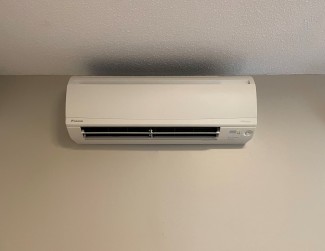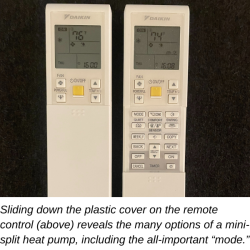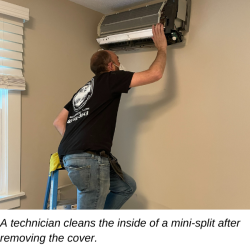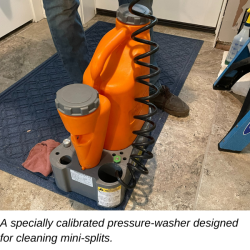Last summer I bought my first home. On the day I met my house-to-be, one of the first things I noticed was its system of ductless mini-split heat pumps. I was immediately excited. From my work at ACEEE, I knew that heat pumps are one of the most energy-efficient ways to heat and cool a home (they use less than half the energy of electric resistance heat over the course of a heating season and also provide efficient air-conditioning; rather than burning fuel to create heat, they move heat from one location to another). If the electricity that powers them comes from renewable sources, they can also help us transition away from fossil fuels. Having looked at other homes with old, inefficient heating systems and no air-conditioning, I knew I would much rather have a heat pump system (without having to go through a retrofit myself).
My home is in Vermont, but before moving here I lived for five years in Washington and Oregon, two states that have prioritized the transition to heat pumps and home electrification. I frequently heard my Pacific Northwest neighbors rave about their heat pumps, particularly the air-conditioning feature as the region’s summers—historically relatively cool—are bringing more heat waves. I had rented one home with a heat pump and knew I liked it, so it was a definite draw for me when I was a prospective buyer.
But I still had a lot to learn. I moved in during hot, humid August, and I was eager to get the AC going. Each room has its own mini-split unit. One room was nice and cool, but I couldn't get the other rooms—including my bedroom—equally comfortable. Only after contacting the installer did I learn my first two important lessons
Lesson 1: Know your remote. A lot of a mini-split’s functionality is hidden in the remote control. Just as you know your own TV remote and have to figure out a hotel’s, my Washington rental home had a Mitsubishi heat pump, but my new house has Daikin. It turns out most of the Daikin's functionality is hidden under a sliding plastic cover I hadn't noticed in my haste to cool down the house. Slide it down and you'll see all the options you need.
Lesson 2: Mode selection is key. Mini-split heat pumps have both indoor units (an air-handler sometimes called a "head") and outdoor units (the compressor/condenser). You can have two or three indoor heads connected to the same outdoor compressor, but all the heads need to be on the same mode. For example, if you have two bedrooms connected to the same compressor but each with its own head, you can't have one on heating mode and one on cooling mode. But you can have different cooling setpoints, such as keeping a bedroom or workout room cooler than the rest of the house—I love this feature. Changing the mode is as easy as pressing the "mode" button and watching an icon change from sun (heat) to snowflake (cool). Once I figured this out, I switched all my units to cooling mode and was amazed at how comfortable they kept the house.
Once I learned the basics of using my heat pump system, I was thrilled with it. Although some experts say that a backup source of (fossil) fuel heat might be needed in the coldest climates, my system got me through my first Vermont winter in total comfort. I was never tempted to turn on the small electric resistance backup heaters in my house.
Being new to homeownership and to maintaining a house, one question had nagged me: Did I need to have these heat pumps cleaned? I’d heard mixed opinions on this, but having no idea if the previous owner had done any maintenance, and knowing the importance of indoor air quality, I decided to hire a local company, We Clean Heat Pumps, to do a thorough cleaning. I was nervous they would find damage from deferred maintenance, but it turned out to be a great experience: a knowledgeable, experienced technician came to my house and spent several hours thoroughly cleaning each indoor and outdoor unit and answering my many questions. Thanks to his visit, I learned more useful lessons:
Lesson 3: Heat pumps do more than cool and heat. The technician showed me how to use the mini-split's "dry" setting correctly (this is technically a “cool” setting to dehumidify using a low fan speed, so if you have two heads on the same compressor, you can have one on “dry” and one on “cool;” I do this often in the summer). I’d already put a stand-alone dehumidifier in the basement (ENERGY STAR® of course), but since putting the heat pump on “dry” mode, the amount of water collecting in the dehumidifier's bucket has decreased dramatically, and I have noticed how cool the basement stays using both “dry” mode and the standalone dehumidifier. I've also noticed a decrease in certain insects that seek out humid spaces, and it's reassuring to know this should also help prevent mold and mildew. If it’s humid but not too hot, you can use the heat pump system as a whole-house dehumidifier. Also, the mini-splits are nearly silent—much quieter than both the dehumidifier and every window AC unit I’ve ever heard.
Lesson 4: Cleaning is important, but it doesn’t have to be difficult. Once a quarter, you should remove the filters and gently wash off any debris. If they look really dirty, you can do this more often. I am not particularly handy or tech-savvy, but I am now confident I can do this. Be careful using any pressure-washing devices on the delicate “fins” of your unit as they can be easily damaged if you are too aggressive. Heat pump technicians have specially calibrated pressure washers. Do not spray any chemicals into the indoor or outdoor units. A professional cleaning once a year will help keep your system running efficiently and identify maintenance needs so you don’t get stuck with a malfunction in cold or hot weather.
Lesson 5: Protect your heat pumps when you work on your house. Many contractors—HVAC or otherwise—are not yet familiar with heat pumps. If you are having work done on your house, even something basic like painting, take simple steps to protect your indoor units from dust and debris. Covering them with a plastic bag or sheet should work fine. One of my mini-split covers was caulked to the wall for unknown reasons. The technician detached it but noted that he sees all sorts of strange things in homes: from needless caulking to units located behind built-in furniture. This was a reminder that the field experience of technicians, installers, and users is unlikely to be identical from one home to the next.
In my case, the professional cleaning was well worth the money. I have peace of mind knowing I'm maintaining my system and taking an important step toward good indoor air quality (recognizing that good indoor air quality depends on many factors beyond your HVAC system, including cooking and combustion, pets, dampness, and sources of pollution [furnishings, chemical products, activities like smoking]).
For people to be happy with their heat pumps—which is critical to market transformation—they need to know how to use them properly and how to optimize their performance for a comfortable home.



